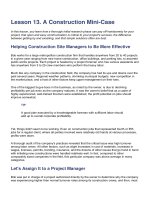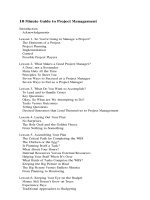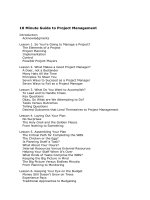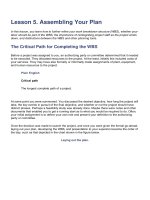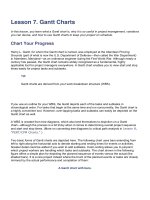A guide to project management Frank Heyworth potx
Bạn đang xem bản rút gọn của tài liệu. Xem và tải ngay bản đầy đủ của tài liệu tại đây (1.69 MB, 48 trang )
European Centre for Modern Languages
Centre européen pour les langues vivantes
COUNCIL
OF EUROPE
CONSEIL
DE L’EUROPE
A guide to project management
A guide to project management
Frank Heyworth
In 1994, upon the initiative of Austria and the Netherlands, with special support
from France, eight states founded the European Centre for Modern Languages
(ECML) as an Enlarged Partial Agreement of the Council of Europe. It was to
become “a forum to discuss and seek solutions to the specific tasks and
challenges that face them in the coming years and which will play a decisive
role in the process of European integration”. At the time of writing, thirty-two
states
1
subscribe to the Partial Agreement. Following a successful initial trial
period (1995-1998), the continuation of the activities of the Centre was
confirmed by Resolution (98) 11 of the Committee of Ministers.
The aim of the Graz Centre is to offer – generally through international
workshops, colloquies and research and development networks and other expert
meetings – a platform and a meeting place for officials responsible for language
policy, specialists in didactics and methodologies, teacher trainers, textbook
authors and other multipliers in the area of modern languages.
A guide to project management is the fourth in a series of publications edited
within the framework of the first medium-term programme of the ECML (2000-
2003).
The ECML’s overall role is the implementation of language policies and the
promotion of innovations in the field of teaching and learning modern
languages. The publications are the results of research and development project
teams established during workshops in Graz. The series highlights the dedication
and active involvement of all those who participated in the projects and in
particular of the group leaders and co-ordinators.
1 The 32 member states of the Enlarged Partial Agreement of the ECML are: Albania, Andorra, Armenia,
Austria, Bosnia and Herzegovina, Bulgaria, Croatia, Cyprus, Czech Republic, Estonia, Finland, France, Germany,
Greece, Hungary, Iceland, Latvia, Liechtenstein, Lithuania, Luxembourg, Malta, Netherlands, Norway, Poland,
Romania, Slovak Republic, Slovenia, Spain, Sweden, Switzerland, „the former Yugoslav Republic of
Macedonia”, United Kingdom.
1
A Guide to Project Management
Frank Heyworth
European Centre for Modern Languages
Council of Europe Publishing
2
Cover design: Gross Werbeagentur Graz
Layout: Stenner + Kordik, Graz
Illustrations: Benoît Cliquet
Printer: Druckerei Khil, Graz
Council of Europe Publishing
F-67075 Strasbourg cedex
ISBN 92-871-4965-8
© Council of Europe, September 2002
Printed in Graz
French edition:
Guide de gestion de projets
ISBN 92-871-4963-5
All rights reserved. No part of this publication may be reproduced or transmitted
in any form or by any means, electronic (CD-ROM, Internet etc.) or mechanical,
including photocopying, recording or any information storage or retrieval system,
without the prior permission in writing from the Publishing Division, Communi-
cation and Research Directorate.
The opinions expressed in this publication are not to be regarded as reflecting the
policy of any gouvernement, of the Committee of Ministers or the Secretary
General of the Council of Europe.
3
Table of Contents
Introduction 5
1. What’s a project? 7
2. Projects and innovation 10
3. Project planning 13
4. Making a budget and cost control 18
5. People make projects work 22
6. Presenting and “selling” your project 26
7. Keeping to deadlines 29
8. Approaches to project evaluation 33
9. Converting projects to every day practice 38
10. Managing international projects 40
Appendix: 10 questions for project managers 43
The Guide is accompanied by a CD-ROM containing resources
to be used in project planning.
4
5
Introduction
This guide has been produced to offer assistance to those
responsible for, or involved in, educational projects related
to language education. It is hoped that it will be of help
specifically to participants in ECML workshops and other
activities, but also on a much wider scale to those undertaking
projects in other contexts. It is the result of a preparatory
study and a workshop in Graz on “innovatory approaches to
language education” held in November 1999 and two regional
workshops held in Budapest and Liechtenstein in 2000. Many
of the ideas in it come from the facilitators and participants
in these workshops.
Frank Heyworth
6
7
1. What’s a project?
1. What’s a project?
8
1. What’s a project?
1 Source: Rey-Debove, Josette; Rey, Alain. Le Nouveau Petit Robert. Paris: Dictionnaire Le Robert, 1993.
2 Source: Oxford Advanced Learner’s Encyclopedic Dictionary. Oxford: Oxford University Press, 1992.
The staff meeting is just coming to an end and there’s been a lively debate on
the school’s system for end-of-course assessment. A lot of the teachers are
unhappy with the present tests because they find them too grammar based and
this doesn’t fit with the kind of communicative teaching that is used in class.
However no one has any clear ideas about exactly what kind of system to replace
it with… So, it’s been decided to appoint a project group to make proposals.
International networking for language education
The Languages Foundation invites project proposals from groups interested in
and able to promote international exchanges between schools, using Internet
resources. The projects should contribute to the enhancement of language
learning, especially in lesser-used languages and to increased awareness of
other cultures. Project proposals should contain full details of the objectives of
the project, the qualifications and experience of those carrying it out and the
resources needed.
These are typical examples of how projects start – to deal with a specific perceived
problem which cannot be solved within the everyday running of an institution
or in response to an opportunity coming from outside.
But what exactly do we mean by a “project”?
It’s one of those international words which mean different things in different
languages. Here are three dictionary definitions:
German: Projekt – geplante oder bereits begonnene
größere öffentliche Unternehmung (a major public
undertaking, planned or already begun)
French: Projet – Travail, rédaction préparatoire; premier
état (first draft, preliminary description of an undertaking)
1
English – Plan for a scheme or undertaking
2
In the guide we are using a meaning close to the English definition and as used
widely in educational contexts. A project is an undertaking designed to examine
present practice, to propose change and to test the implementation of change.
9
1. What’s a project?
Here are some of the characteristics
Projects are different from ordinary work. They are
intended to change things
Projects have a timeframe with a beginning and an end
Projects have to be planned
Projects use resources and need a budget
Projects require evaluation – the criteria for evaluation need
to be established from the beginning
Projects have an outcome, which is not necessarily known
at the outset
The outcome is very often a “product” of some kind
At the end of a project, decisions need to be taken about
whether to use or institutionalise the outcome
Projects involve people
Think it over
Reflect on projects you’ve been involved in or know about. Try to describe them
taking account of the characteristics above. What were the most successful
features of the project? What (if anything) went wrong? What was the outcome
of the project? Did it have any lasting effect?
“I’ve got this great idea and if we can just get a couple of million dollars
sponsorship, we could turn it into a concept”
(conversation overheard at a Californian cocktail party
in Woody Allen’s film Manhattan)
self-assessment questionnaire
10
2. Projects and innovation
2. Projects and innovation
Projects are designed to promote change and innovation. They provide
opportunities to test possible innovations in a protected environment without
taking the decision to change established practice until it can be shown that
the new ideas work.
11
2. Projects and innovation
So, a good first question in project planning is “do we need to change?” A good
first principle is:
Look at present practice
Is it OK?
Yes!! – keep it and reinforce it
No!! – change and innovate
Are you ready to innovate?
Here are some of the necessary conditions for successful innovative projects
a) a feeling of dissatisfaction with the way things are done at
the moment
b) a vision of what you would like to achieve (so you need to
go beyond criticism of the present situation to describing
what would be a satisfactory situation)
c) a clear idea of the first steps to be taken to initiate change
(you don’t need to know everything – you wouldn’t need
a project if you did – but you do have to have an idea of
where to start)
d) an idea of what the cost of change will be (this doesn’t
just mean money; the cost of a project can be seen in terms
of the time it will take, the stress of carrying through
change, the other opportunities you miss by choosing this
option)
If you look at a possible project and decide that a, b and c are greater than the
cost, then you are probably ready to start planning a project.
12
2. Projects and innovation
Here’s an example
A group of language schools was unhappy with its system
for issuing end-of-course certificates. These tended simply
to record the level of the class attended and didn’t give
information about real-life communicative competence or
individual progress or achievement. They had a vision of a
coherent system of clearly described levels, of interesting
communicative kinds of assessment recorded in a
certificate which would show – in language accessible to
everybody – the learners’ language competence. They
planned to start the project with a questionnaire to learners
to determine what their priorities were for communicative
skills and to do a review of available testing materials. They
were aware that it was an ambitious project, but found
the resources to put a three person team on the job, taking
the project leader out of teaching for a six month period.
The project turned out to be a very successful one, leading
to the development of scales of descriptors and new
approaches to using simulations for assessment. It did,
however, take seven years instead of six months!
Think it over
Reflect on your own situation. Think of an area where you are dissatisfied with
present practice and apply the test on readiness to innovate.
“The need to be right all the time is the biggest bar to new ideas. It is better to
have enough ideas for some of them to be wrong than to be always right by
having no ideas”
Edward de Bono
self-assessment questionnaire
13
3. Project planning
3. Project planning
Projects don’t just happen; they need to be planned. They usually come in
addition to normal work or in a limited period where the project participants
are released from their usual duties. They need to be completed within set
deadlines and have a limited budget.
14
3. Project planning
So here is a checklist to help project pre-planning:
Issues Comments
What’s the title It’s a good idea to find a memorable name for a
of the project? project. It gets people interested, and helps
participants to identify with it.
What are the aims State these as accurately and specifically as you can.
of the project? There is often a temptation to try and do several
things at the same time, but projects with a clear focus
usually work best. Here are some useful expressions to
use in stating project aims:
● To review and assess present practice …
● To survey …
● To make recommendations for…
● To develop materials for …
● To provide guidelines
● To plan the implementation of …
● To pilot innovatory material
● To test the effect of …
A clear statement of objectives is a useful way of
keeping clear priorities and avoiding false expectations.
What is will be Projects need some tangible product or they just
the outcome disappear. This can be a project report, a set of
of the project? recommendations, a plan, teaching materials, a training
programme, a development strategy.
What negative Projects can have negative effects – other members of
effects do you risk? staff who feel excluded; dissatisfaction with the
present state of affairs; lack of focus on day-to-day
matters etc.
15
3. Project planning
Who will be Make the roles of the project team members clear from
involved? the beginning. Projects can work as group democracies,
but it usually helps to have a project leader who is
responsible for organisation and for seeing that
deadlines are kept. Project team members will often
do a lot of extra work, but putting too much stress
will often be counter-productive in the long run.
Who are the “Stakeholders” means all the people who are affected
stakeholders? by the project learners, other members of staff,
parents etc.
What are the It’s important to divide the time plan into phases with
deadlines? fixed points for reporting and review (see section 6 for
advice on flowcharts and time planning).
How much will A project team is accountable for the resources used so
it cost? it’s vital (a) to plan the budget (see section 5) (b) decide
who can authorise payments (c) have a proper tracking
system so you know where you are. Costs include time,
materials, consumables, meeting and travel costs etc.
Who will assess Doing a project involves being accountable to an
the project? institution, a group etc. Define the assessment criteria
Using what criteria? at the outset and taking account of the defined aims.
Your answers to these questions will be the basis for an action plan for the
project.
16
3. Project planning
Making an action plan
This involves translating the plan into a detailed account of the different steps
in the project, indicating who is responsible for them, the timescale for the
different phases and their outcomes. An action plan can be presented in a table:
Person in Deadline for
Action
charge
Start time
completion
Outcome
Initial project meeting
Phase one
1.
2.
3.
Phase one review meeting
Phase two
1.
2.
3.
Phase two review meeting
Phases
continued until
project
completed
Final review meeting and presentation of project report
17
3. Project planning
Each phase can then have its own action plan
Target
Tasks Participants
Audience
Deadline Assessment
1.
2.
3.
4.
5.
self-assessment questionnaire
template of these tables
18
4. Budget and cost control
4. Making a budget and cost control
What does a project cost? When you’re doing a project proposal, especially if
it’s a competitive bid, you need to make an attractive budget proposal. When
you come to the end of the project you usually have to justify what you have
spent, so it’s important to make it realistic in the first place.
19
4. Budget and cost control
So, what kind of costs are there in a project?
Cost type How to calculate it
Project Calculate either in hours or days allocated for doing the
participants’ time work. The easiest way is to take an annual salary and to
divide it by the number of working days in the year
(e.g. someone with 5 weeks holiday a year works for
47 weeks x 5 days a week = 235 days). If you want an
hourly cost divide this by the number of working hours
per day, say 8.
Meeting and If the project involves participants travelling to meetings,
travel costs you need to calculate (a) the average cost of travel
(b) the average cost of overnight accommodation and
(c) fix a sum for a daily meals allowance.
Communications The costs of phones, letters and faxes can sometimes
be absorbed by the institution; if not, you’ll need to
calculate the likely costs.
Printing and Will your project lead to materials production or a
publication costs publication? If so, you need to get an estimate from the
printers or the organisation producing the materials.
Don’t forget the costs of distributing the materials if
this is part of your aims. CD-ROMs are often
cheaper than print nowadays.
Hardware and Do you have access to the computers and other hardware
software you need for the project? Some publicly funded project
sources will contribute to buying what you need.
20
4. Budget and cost control
Calculating and recording the costs
The most important thing is to make sure you record each expenditure when
you make it, keeping a receipt, if possible.
You can do your bookkeeping with a pencil and a little blue notebook, but it’s
much easier if you do it with a computer. There are lots of simple accounting
programmes. Bookkeeping programmes, such as Quicken, are not expensive,
are easy to use and allow you to post expenditure according to budget categories
and generates a range of different reports.
The easiest way to record overall results is to use a spreadsheet programme like
EXCEL. This will do the additions automatically and compare your actual costs
with the budget. Here’s what a spreadsheet looks like:
Materials development quantity unit cost actual cost budget difference
project
Staff costs
Project team member 1 12 80 960 880 -80
Project team member 2 6 75 450 525 75
Project team member 3 9.5 60 570 540 -30
Total staff costs 1.980 1.945 -35
Meeting costs
Meeting 1 6 50 300 250 -50
Meeting 2 10 50 500 450 -50
Meeting 3 15 50 750 700 -50
Total meeting costs 1.550 1.400 -150
Overall project
spending 3.530
Overall budget 3.345
Budget compared
with results -185
21
4. Budget and cost control
sample budget spreadsheet
Some useful tips on managing budgets
It’s a good idea to have one person responsible for
authorising expenditure, so that the budget isn’t overspent
because different team members have spent the same
money
Budgets never work out exactly – some things cost more,
occasionally less than you think. If you can convince those
who are providing the money, try to build in an extra 5%
for “unforeseen expenditure”
Budgets never work out exactly; you need to be flexible,
perhaps saving in one area to cover extra costs in another
If you are over budget, don’t try to hide the facts – present
the problem as clearly as you can to those in charge
Build in a financial review into every progress review
meeting
Anyone can make a mistake, but remember:
“Les bons comptes font les bons amis”
22
5. People make projects work
5. People make projects work
Projects almost always involve teams so promoting good teamwork is essential
to success.
23
5. People make project work
Are any of these complaints familiar?
“I’m not sure exactly what I’m expected to do.”
“Everyone works in her own little corner; there’s no sharing
of experience.”
“It’s just a lot of extra work, without any real reward.”
“The rest of the staff resent the project time we have –
they think it just means extra work for them.”
The pillars of successful teamwork
Communication Motivation
Involvement Commitment
